Commitment
to increased future global warming
to increased future global warming
Today's global average temperature increase from pre-industrial times is 1.0C which is already having disastrous impacts on all continents.
Our global warming commitment in time is practically forever, as it will last over a thousand years. Whatever the eventual warming therefore it is practically irreversible- Susan Solomon PNAS 2009 Irreversible climate change due to carbon dioxide emissions.
The reason for this is the ocean heat lag and mainly the ultra long life time of carbon emissions. It used to be assumed that CO2 lasted in the atmosphere 100-200 years. In the IPCC 2007 assessment 20% of CO2 emissions last 1000 years from an instant CO2 pulse model. How ever a more realisitic model published in 2007 'Long term fate of anthropogenic carbon' found that 'About 75% of CO2 emissions have an average perturbation lifetime of 1800 years and 25% have lifetimes much longer than 5000 years.' Carbon emissions are for sure practically for ever then.
Our global warming commitment in time is practically forever, as it will last over a thousand years. Whatever the eventual warming therefore it is practically irreversible- Susan Solomon PNAS 2009 Irreversible climate change due to carbon dioxide emissions.
The reason for this is the ocean heat lag and mainly the ultra long life time of carbon emissions. It used to be assumed that CO2 lasted in the atmosphere 100-200 years. In the IPCC 2007 assessment 20% of CO2 emissions last 1000 years from an instant CO2 pulse model. How ever a more realisitic model published in 2007 'Long term fate of anthropogenic carbon' found that 'About 75% of CO2 emissions have an average perturbation lifetime of 1800 years and 25% have lifetimes much longer than 5000 years.' Carbon emissions are for sure practically for ever then.
The latest from the 2014 IPCC AR5 assessment.
'The climate system has multiple time scales, ranging from annual to multi-millennial, associated with different thermal and carbon reservoirs. These long time scales induce a commitment warming ‘already in the pipe-line’. At the current (unprecedented) rate of atmospheric CO2 increase the commitment is another 40-70% of the warming at the time of atmospheric stabilization'
(IPCC AR5 WG1 TS TFE 8).
As atmospheric is increasing at a rate (unprecedented) of 15 per year our climate system inertia commitment is 40-70%. The IPCC AR4 estimated 'constant composition' or constant heat at another 0.6C by 2100 from 2000 warming of 0.7C, so another 70% is certainly most likely.
A paper June 2015 paper makes the situation clearer on today's emissions.
' A robust finding of these studies is that the CO2-induced warming persists for many centuries.
[...] Our results indicate that as CO2 continues to accumulate in the atmosphere, the full warming effect of an emission may take several decades, if not centuries to emerge. A large fraction of the warming, however, will be realized relatively quickly (93% of the peak warming is realized 10 years after the emissions for the 1000 PgC pulse). This implies that the warming commitment from past CO2 emissions is (relatively)small, and that future warming will largely be determined by current and future CO2 emissions. Each additional CO2 emission will contribute to warming that will persist almost indefinitely. Thus, emission reductions implemented today will equally benefit current and future generations.'
A 2008 paper is a classic (rare) on combining climate sciecne with ethics, On avoiding dangerous anthropogenic interference with the climate system.. (Ramanathan, Feng) The estimated warming of 2.4°C is the equilibrium warming above preindustrial temperatures that the world will observe even if GHG concentrations are held fixed at their 2005 concentration levels
Climate scientists have 3 definitions of 'commitment'. It is usually applied to the ocean heat lag. A temperature increase at the time of atmospheric GHG stabilization is called the 'realized' or 'transient' warming because it not the the full 'equilibrium' caused by that atmospheric GHG concentration. Because of time lags inherent in the Earth’s climate, warming that occurs in response to a given increase in the concentration of carbon dioxide (“transient climate change”) reflects only about half the eventual total warming (“equilibrium climate change”) NRC Climate Stabilization Targets 2010 p9.
There is no one definition of climate change commitment by the scientists. The IPCC AR4 gives thee definitions saying none of them are the actual 'unavoidable' commitment, so here we look at what we call the practically unavoidable commitment - certainly with an all out emergency response. This total real world commitment has not been estimated by the climate science.
However in general there are two big sources of commitment.
However the IPCC AR4 mitigation charts show we are today committed to a 2.4C warming up to a possible 4C. It is odd that this has received so little attention because the IPCC in 2007 were most definite that action had to be taken NOW.
We calculate our future commitment (like all effects of atmospheric GHG pollution by the climate sensitivity- how much will be planet from a unit increase in atmospheric CO2 and other GHGs. According to climate experts James Hansen and also Richard Zeebe the metric we are using is a large underestimate of long term warming because the metric does account for the largest future feedback warming. This immediately greatly increases estimates we have of future commitment.
James Hansen has for years warned we are committed to more warming because of GHG warming that is still 'in the pipe'. Today we are 0.8C. There is another 0.8C in the ocean heat lag and Hansen estimates the socio-economic lag to replace all the fossil fuel energy in the world is another 0.8C. This is explained by Hansen by a section he wrote Skeptical Science Why it's urgent we act now on climate change.
James Hansen's famous 2008 350ppm paper is a scientific call for emergency action because we are far above 350 ppm CO2 now practically at 400 ppm. and Hansens words in the paper are If the present overshoot of this target CO2 is not brief, there is a possibility of seeding irreversible catastrophic effects. Clearly we must be treating climate change as a planetary emergency.
One paper that does address commitment is a 2008 paper by Ramanathan and Feng Avoiding Dangerous Climate that calculates the ocean heat lag and the aerosol effect (alone) commits us to 2.4C. This is an important paper because it points that the 'hidden' warming of air pollution aerosol cooling must be included as a commitment today. It is being ignored for policy making.
The chart of impacts and temperature increases is modified to show the allowable temperature limit to prevent an impact that is caused by a particular degree of warming - to allow for just the ocean heat lag.
Because there are already many disastrous global warming driven impacts happening on all continents we are committed to far worse impacts- even if the world were to respond on an emergency basis.
In the case of global warming and climate change the science of climate change commitment must be understood and applied as the most policy relavent guide for policy and planning. In other words we should focus on today's committed warming rather than today's global temperature increase.
Quite simply the unavoidable climate change commitment means that today's global warming is only a fraction of the unavoidable commitment to future global warming which will result from the heat energy in the climate system caused by the accumulation of heat radiating greenhouse gases in the lower atmosphere today (the radiative forcing).
'The climate system has multiple time scales, ranging from annual to multi-millennial, associated with different thermal and carbon reservoirs. These long time scales induce a commitment warming ‘already in the pipe-line’. At the current (unprecedented) rate of atmospheric CO2 increase the commitment is another 40-70% of the warming at the time of atmospheric stabilization'
(IPCC AR5 WG1 TS TFE 8).
As atmospheric is increasing at a rate (unprecedented) of 15 per year our climate system inertia commitment is 40-70%. The IPCC AR4 estimated 'constant composition' or constant heat at another 0.6C by 2100 from 2000 warming of 0.7C, so another 70% is certainly most likely.
A paper June 2015 paper makes the situation clearer on today's emissions.
' A robust finding of these studies is that the CO2-induced warming persists for many centuries.
[...] Our results indicate that as CO2 continues to accumulate in the atmosphere, the full warming effect of an emission may take several decades, if not centuries to emerge. A large fraction of the warming, however, will be realized relatively quickly (93% of the peak warming is realized 10 years after the emissions for the 1000 PgC pulse). This implies that the warming commitment from past CO2 emissions is (relatively)small, and that future warming will largely be determined by current and future CO2 emissions. Each additional CO2 emission will contribute to warming that will persist almost indefinitely. Thus, emission reductions implemented today will equally benefit current and future generations.'
A 2008 paper is a classic (rare) on combining climate sciecne with ethics, On avoiding dangerous anthropogenic interference with the climate system.. (Ramanathan, Feng) The estimated warming of 2.4°C is the equilibrium warming above preindustrial temperatures that the world will observe even if GHG concentrations are held fixed at their 2005 concentration levels
Climate scientists have 3 definitions of 'commitment'. It is usually applied to the ocean heat lag. A temperature increase at the time of atmospheric GHG stabilization is called the 'realized' or 'transient' warming because it not the the full 'equilibrium' caused by that atmospheric GHG concentration. Because of time lags inherent in the Earth’s climate, warming that occurs in response to a given increase in the concentration of carbon dioxide (“transient climate change”) reflects only about half the eventual total warming (“equilibrium climate change”) NRC Climate Stabilization Targets 2010 p9.
There is no one definition of climate change commitment by the scientists. The IPCC AR4 gives thee definitions saying none of them are the actual 'unavoidable' commitment, so here we look at what we call the practically unavoidable commitment - certainly with an all out emergency response. This total real world commitment has not been estimated by the climate science.
However in general there are two big sources of commitment.
- Socio-economic inertia
- Climate system science inertia
However the IPCC AR4 mitigation charts show we are today committed to a 2.4C warming up to a possible 4C. It is odd that this has received so little attention because the IPCC in 2007 were most definite that action had to be taken NOW.
We calculate our future commitment (like all effects of atmospheric GHG pollution by the climate sensitivity- how much will be planet from a unit increase in atmospheric CO2 and other GHGs. According to climate experts James Hansen and also Richard Zeebe the metric we are using is a large underestimate of long term warming because the metric does account for the largest future feedback warming. This immediately greatly increases estimates we have of future commitment.
James Hansen has for years warned we are committed to more warming because of GHG warming that is still 'in the pipe'. Today we are 0.8C. There is another 0.8C in the ocean heat lag and Hansen estimates the socio-economic lag to replace all the fossil fuel energy in the world is another 0.8C. This is explained by Hansen by a section he wrote Skeptical Science Why it's urgent we act now on climate change.
James Hansen's famous 2008 350ppm paper is a scientific call for emergency action because we are far above 350 ppm CO2 now practically at 400 ppm. and Hansens words in the paper are If the present overshoot of this target CO2 is not brief, there is a possibility of seeding irreversible catastrophic effects. Clearly we must be treating climate change as a planetary emergency.
One paper that does address commitment is a 2008 paper by Ramanathan and Feng Avoiding Dangerous Climate that calculates the ocean heat lag and the aerosol effect (alone) commits us to 2.4C. This is an important paper because it points that the 'hidden' warming of air pollution aerosol cooling must be included as a commitment today. It is being ignored for policy making.
The chart of impacts and temperature increases is modified to show the allowable temperature limit to prevent an impact that is caused by a particular degree of warming - to allow for just the ocean heat lag.
Because there are already many disastrous global warming driven impacts happening on all continents we are committed to far worse impacts- even if the world were to respond on an emergency basis.
In the case of global warming and climate change the science of climate change commitment must be understood and applied as the most policy relavent guide for policy and planning. In other words we should focus on today's committed warming rather than today's global temperature increase.
Quite simply the unavoidable climate change commitment means that today's global warming is only a fraction of the unavoidable commitment to future global warming which will result from the heat energy in the climate system caused by the accumulation of heat radiating greenhouse gases in the lower atmosphere today (the radiative forcing).
Committed warming is a term used in the first 1990 expert report on a limit to global warming. (1990 Stockholm Environment Institute Targets and Indicators of Climatic Change F. Rijsberman, R. Stewart) 'Two absolute temperature targets for committed warming were identified. They were 1C and 2C. However this committed warming is not being used now in setting climate change policy.
Committed warming is currently increasing at 2X the rate of global warming (B. Parker Feb 2017).
POLICY National emissions targets today commits the world to 3.2C by 2100 (Climate Action Tracker)
which is 4C by 2300, by factoring in climate system commitment.
1C at 2017
At 1C global warming today (2017) we are committed to much more over the very long term
from several ways of estimating.
Total committed global warming (& climate change) is much higher than today's 1C (2017) is due to time lags that result from (1) policy inertia,
(2) socio-economic inertia and (3) the science of climate system inertia. None of these are being addressed in any concerted way.
1) Policy inertia is extreme, with the national emissions targets (INDCs) filed with the UN leading to a substantial INCREASE in global emissions
by 2030 and a catastrophic global warming of over 3C by 2100. Due to climate system inertia that will be much higher
long after 2100.
2) Socio-economic inertia would be the time from a global emergency response decision to global emissions being near zero.
Emissions must be near zero for atmospheric greenhouse gases to stabilize (the atmospheric increase comes to a complete
stop). This lag results from the time taken for serious policy to take effect and the time for all fossil fuel energy to be replaced
with clean renewable energy. If (God forbid) fossil fuel infrastructure is allowed to run out its expected shelf life,
this commitment is extremely large. The IPCC AR5 says this lag could add another 1C alone.
3) Climate system commitment. This is the unavoidable lag to full long term equilibrium warming (long after 2100)
from the time of atmospheric GHG stabilization. This unavoidable lag to equilibrium surface warming is due to the ocean
heat inertia (combined with the long atmospheric lifetime of CO2 emissions). The vast majority of the heat from GHG
emissions goes to ocean heat (total ocean warming). Depending on various factors this ocean heat source could
add another 50% to 100% of the global warming at the time of GHG stabilization. The first IPCC 1990 assessment estimated
that was an extra commitment of 100% and (though it is seldom quoted) so does the 5th 2014 IPCC assessment.
The ocean heat lag results in a more immediate lag as well. It takes for most most of the global surface warming
to register from GHG emissions, though much of the global warming will register in one decade. The higher the atmospheric
GHG levels are allowed to go the greater this lag time becomes. ( 2015 ERL) The time lag between a carbon dioxide
emission and maximum warming increases with the size of the emission and the amount iof atmospheric GHGs .
How ever, now that warming is going over 1C (2017) amplifying climate feedbacks may add even more
emissions and more global surface warming. The reason is at 1C the ocean heat lag is a commitment to about
2C (IPCC AR5) and feedback emissions from 1.5-2C are expected to be large enough to add more warming over the
long term.

CLIMATE SYSTEM EMERGENCY INSTITUTE
The health and human rights approach to climate change
The health and human rights approach to climate change
Research
by date
4 Jan 2021 Greater committed warming after accounting for the pattern effect. by 2100 over 1.5C, full equilibrium over 2C (long after 2100)
12 Feb 2017 B. Parker MIT Radiative Forcing, Climate Sensitivity, and Global Warming We are committing ourselves to a temperature increase of about .45°C per decade when all of the factors are considered.
Oct 2016 C. Snydrer Evolution global temp past 2M yrs. Earth system sensitivity of 9C ...today’s greenhouse gas levels may already commit Earth to an eventual total warming of 5 degrees Celsius over the next few millennia
March 2015 K. Zickfeld
The time lag between a carbon dioxide emission and maximum
warming increases with the size of the emission
Dec 2014 K. Caldiera
Maximum warming occurs about one decade after a carbon dioxide emission
Sept 2014 S. Leahy We Have Five Years to Stop Building Coal Plants and Gas-Powered Cars
2008 Ramanathan, Feng On avoiding dangerous anthropogenic interference with the climate system..
2001 R, Wetherald. Committed warming and its implication to climate change
by date
4 Jan 2021 Greater committed warming after accounting for the pattern effect. by 2100 over 1.5C, full equilibrium over 2C (long after 2100)
22 Jan 2019 New calculations show scientists have grossly underestimated the effects of air pollution
12 Feb 2017 B. Parker MIT Radiative Forcing, Climate Sensitivity, and Global Warming We are committing ourselves to a temperature increase of about .45°C per decade when all of the factors are considered.
Oct 2016 C. Snydrer Evolution global temp past 2M yrs. Earth system sensitivity of 9C ...today’s greenhouse gas levels may already commit Earth to an eventual total warming of 5 degrees Celsius over the next few millennia
March 2015 K. Zickfeld
The time lag between a carbon dioxide emission and maximum
warming increases with the size of the emission
Dec 2014 K. Caldiera
Maximum warming occurs about one decade after a carbon dioxide emission
Sept 2014 S. Leahy We Have Five Years to Stop Building Coal Plants and Gas-Powered Cars
2008 Ramanathan, Feng On avoiding dangerous anthropogenic interference with the climate system..
2001 R, Wetherald. Committed warming and its implication to climate change
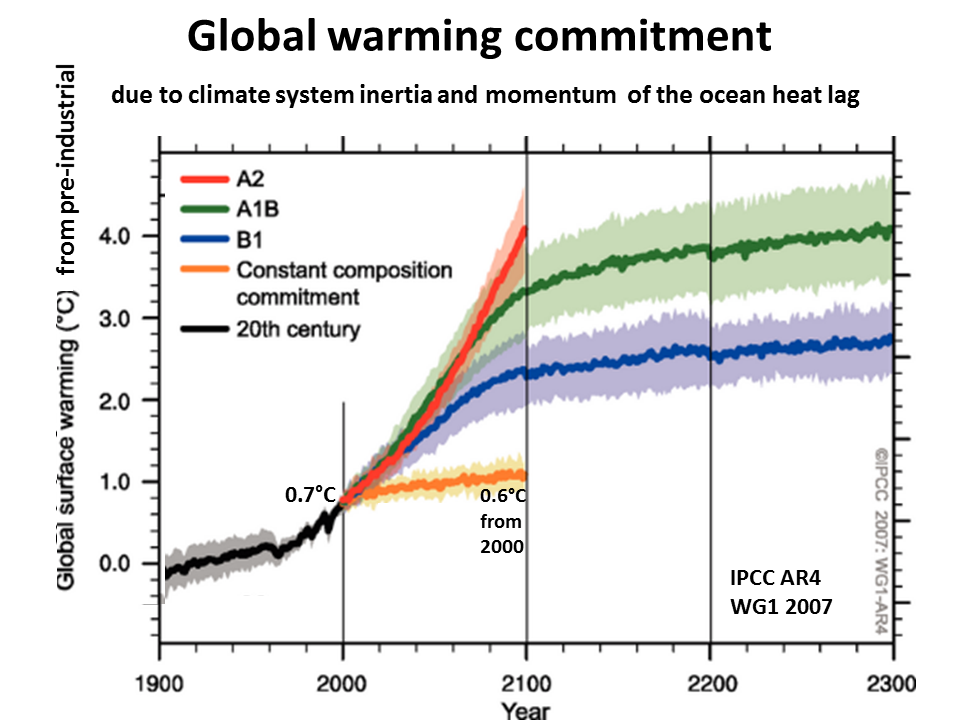
The IPCC 20-18 1.5C Special Report is the latest on the issue, which claims that
The 2014 IPCC assessment estimates the commitment due to atmospheric greenhouse gases at 2.0C.
The commitment from constant greenhouse gas concentrations would correspond to approximately 2C warming IPCC AR5 WG1 12.5.2. page 1108.. The IPCC AR5 estimates that commitment is at least an extra 0.6C by 2100 and over another 1C by 2300. That is over 2C.
'AOGCMs estimated a most likely value of about 0.6°C for 2100 (relative to 1980–1999, AR4). CMIP5 results are consistent with those numbers, with an additional warming of about 0.5°C 200 years after stabilization of the forcing'. (AR5 WG1 CH12 p 1103). This does not include amplifying feedbacks.
This IPCC commitment does not include the extra warming from amplifying feedbacks in any of its projections.
'However, this equilibrium estimate is based on feedbacks estimated for the present day climate. Climate and carbon cycle feedbacks may increase substantially on long time scales and for high cumulative CO2 emissions' (IPCC AR5 WG1 Ch.12 p.1109).
The commitment from constant greenhouse gas concentrations would correspond to approximately 2C warming IPCC AR5 WG1 12.5.2. page 1108.. The IPCC AR5 estimates that commitment is at least an extra 0.6C by 2100 and over another 1C by 2300. That is over 2C.
'AOGCMs estimated a most likely value of about 0.6°C for 2100 (relative to 1980–1999, AR4). CMIP5 results are consistent with those numbers, with an additional warming of about 0.5°C 200 years after stabilization of the forcing'. (AR5 WG1 CH12 p 1103). This does not include amplifying feedbacks.
This IPCC commitment does not include the extra warming from amplifying feedbacks in any of its projections.
'However, this equilibrium estimate is based on feedbacks estimated for the present day climate. Climate and carbon cycle feedbacks may increase substantially on long time scales and for high cumulative CO2 emissions' (IPCC AR5 WG1 Ch.12 p.1109).
The first 1990 IPCCC assessment estimated that we are locked in to double today's warming, and the 2011 NRC Climate Stabilization Targets has the same estimate. That makes today's (2016) warming a commitment to 2C.
Certainly then if we include amplifying feedbacks committed warming to equilibrium will be more than double today's warming.
Certainly then if we include amplifying feedbacks committed warming to equilibrium will be more than double today's warming.
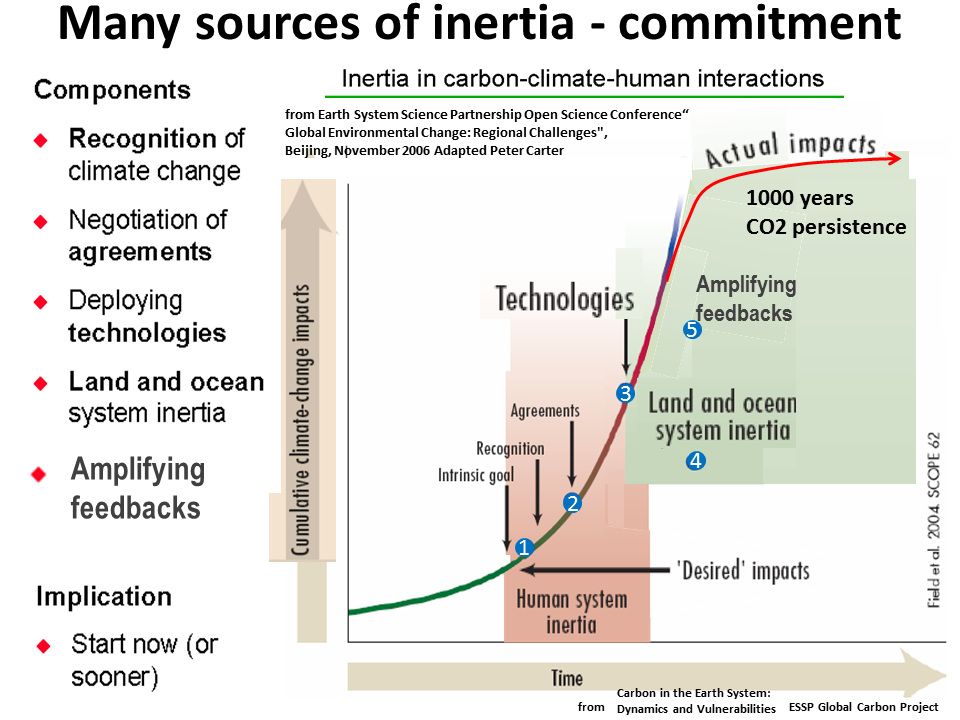

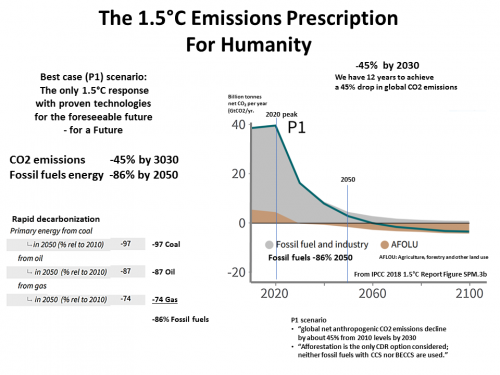
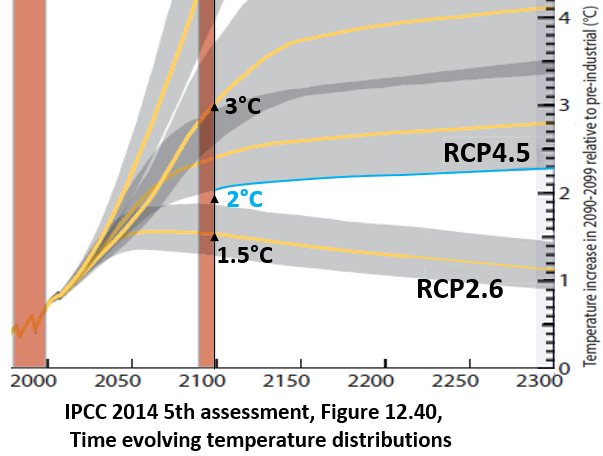
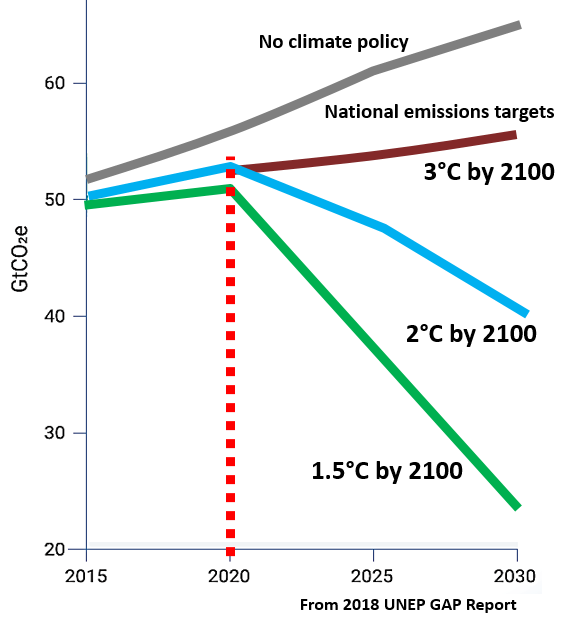
From start of serious global mitigation), a much higher degree of global climate change
is committed (locked in) than is being experienced today. The IPCC 1.5C Report shows the large extra warming from removal of cooling fossil air pollution acid aerosols
This higher commitment has been known since the 1st 1990 IPCC assessment.
A very long term policy horizon is essential to plan for future livable planet so climate change commitment must be assessed to equilibrium warming, centuries after 2100.
The various forms of commitment here are proof of today's dire Earth emergency. Today's global warming has to be linked to the several sources of unavoidable locked in extra warming by climate system inertia for policy making assessment. It is fundamental that limits and policy making must be based on today's future committed warming not today's (realized) warming.
Inertias This includes a number of inertias also uncertainties: political obstructive inertia, inertia from governments setting policies to phase out fossil fuels, legislative and economic inertia for policy to take effect on emissions, technological inertia to replace all fossil fuel energy with renewable energy, higher climate sensitivity that the best guess 3C (the upper IPCC range and various research approaches yield 4.5C and some up to 6C) above, unmasking of fossil fuel air pollution aerosol cooling (could be an extra 1C from 2016 researchReto Knutti, 2015, Reto Knutti, 2015, ocean heat lag inertia (the degree is uncertain), land and ocean carbon sink failure (timing uncertain), and amplifying feed-backs (responses to global warming that are excluded from the projections). The latter will increase with temperature and time may be very large. A future commitment based on the single climate sensitivity of 3 and excluding large amplifying feed-backs is a very low estimate and wrong for policy making (2015 Reto Knutti , Feedbacks, climate sensitivity and the limits of linear models,Phil. Trans. R. Soc. A.).
Today the world is committed to a massively changed and increasingly hostile natural world (already evident at 1C) and could be committed to a future uninhabitable planet, due to combinations of the above triggering multiple huge planetary sources of combined inter-reinforcing extra feedback warming.
Definition There is no single agreed upon definition or derivation of climate change commitment in the science, and commitment has not been used for policy making.
It is agreed that the crucial committed duration of global warming is over 1000 years.
Policy commitment The national emissions targets that have not improved since the 2015 Paris Agreement, lead to global warming of at least 3C by 2100, which is 4.2C by 2300.
Long term committed impacts of global warming are therefore huge, because they increase with global temperature and with time. This has not featured prominently in the science. Carbon feedback emissions that add to the warming will continue increasing for centuries and will increase extreme weather events including forest fires. The loss of Arctic summer sea ice and Far North snow cover (cooling albedo) is a large commitment to a transformed climate system, in particular increasing Northern hemisphere extremes. It will increase global warming directly and by increasing Arctic carbon feedback emissions. Ocean heating, acidification and de-oxygenation with continue for thousands of years as will sea level rise. The only way to limit these to come extent is by immediate (2020) rapid decline in emissions (RCP2.6 in the IPCC AR5 and P1 in the 1.5C Report), otherwise IPCC 2014 shows they all carry on increasing. So any delay from this time on in putting emissions into rapid decline increases future committed warming.
Constant Composition Climate system inertia means there is more heat in the climate system than registers as the realized global surface temperature increase. This committed extra warming (constant composition) is the result of the fact that by far the most of the added lower atmosphere greenhouse gas heat energy goes to the vast oceans. As far back as the IPCC 1990 1st assessment this has been put at double realized warming (2C by IPCC AR5), but this is being regarded now as misleadingly high with respect to today. "The warming commitment from past CO2 emissions is small, and future warming will largely be determined by current and future CO2 emissions. Each additional CO2 emission will contribute to warming that will persist almost indefinitely" (2013, K. Zickfeld). The science does agree that global warming by 2100 will be committed to to increase more long after 2100 as in the IPCC 2014 RCP scenarios extended from 2100 to 2300. Also it is agreed that at 1C today we are committed to 1.5C to 2C, i.e another 50% to 100% of realized warming.
By including extra feedback warming (excluded in projections) double realized warming has a high certainty. Land warming alone (excluding peat and permafrost) is estimated at up to 1.5C by 2100 ( 2012, Ben. B. Booth, High sensitivity of future global warming to land carbon cycle processes).
A lot of the science and policy of commitment consideration is moot if we consider runaway (which is essential), leading to an unavoidable 'hot house Earth'. Permafrost leads to runaway because as it thaws it generates heat from microbial carbon digestion. Over the long term it can add another 3.5C to global warming (2013, K. Zinkfeld) This is a big reason for the old 2C limit (limit now is 1.5C) and the Hothouse Earth paper also put the runaway danger limit at 2C. If There is research that puts this limit at 1.5C (A. Vaks, 2013, A. McDougall 2012). The Arctic alone holds double all atmospheric carbon. This makes a commitment today of 1.5C to 2C an extreme hot house Earth commitment to an unlivable planet.
By all definitions of commitment, 1.5C is locked-in. "Expert judgement suggests that if all anthropogenic emissions were reduced to zero immediately, any further warming beyond the 1°C already experienced would likely be
less than 0.5°C over the next two to three decades, and centuries (IPCC 2018 1.5C ch 1)
A lot of the science and policy of commitment consideration is moot if we consider runaway (which is essential), leading to an unavoidable 'hot house Earth'. Permafrost leads to runaway because as it thaws it generates heat from microbial carbon digestion. Over the long term it can add another 3.5C to global warming (2013, K. Zinkfeld) This is a big reason for the old 2C limit (limit now is 1.5C) and the Hothouse Earth paper also put the runaway danger limit at 2C. If There is research that puts this limit at 1.5C (A. Vaks, 2013, A. McDougall 2012). The Arctic alone holds double all atmospheric carbon. This makes a commitment today of 1.5C to 2C an extreme hot house Earth commitment to an unlivable planet.
By all definitions of commitment, 1.5C is locked-in. "Expert judgement suggests that if all anthropogenic emissions were reduced to zero immediately, any further warming beyond the 1°C already experienced would likely be
less than 0.5°C over the next two to three decades, and centuries (IPCC 2018 1.5C ch 1)
If there is no rapid 2020 global emissions decline, over 2C is committed just by 2100. 2C by 2100 is 2.4C by 2300, but that excludes inevitable extra feedback emissions, and so excludes runaway.
Policy commitment The best known estimated commitment is that due to today's polices (energy and climate) For Policy Commitment (PC) we can use the current and projected actual trend in emissions, and near term economic and energy policies. We are tracking the worst case emissions scenario (37.1 Gt. CO2 2018 Global Carbon Project), RCP8.5 in the 2014 IPCC 5th assessment (AR5) or SRES A1FI in the 2007 4th assessment (AR4). This puts us at about 4.5C (only) by 2100 and it excludes inevitable extra warming from amplifying feedback emissions (e.g. thawing permafrost). The limitation of projected warming to 2100 and exclusion of carbon feedback emissions warming, reflects the current economic bias against rights for future generations.
Today that means a large and growing risk of a climate legacy of an unlivable or even uninhabitable planet.
All energy policies and plans are for very little change in the dominant share of fossil fuel energy (at least 80%) over the next few decades. With the advent of shale oil and gas there is no fossil fuel supply limitation. There is no climate policy being applied to change that. National non binding emissions targets filed wit the UN (INDCs) lead to a substantial increase in emissions by 2030 (UNEP GAP Report 2018, Climate Action Tracker 2018), and those are not being followed because actual CO2 emissions are tracking the worst case scenario.
Geoengineering Commitment cannot be reduced by geoengineering. Assuming large removals of CO2, for which the only evidence is that this is not feasible is wrong in every way. IPCC climate science improperly assumes artificial CO2 removal in its scenarios, except for the best case RCP and 1.5C scenarios. Geoengineering to cool the planet or remove CO2 at best can only bring about small effects and come with disastrous side effects. Direct air capture would be safe but removing CO2 at scale impossible.
Practical climate system commitment. The best practical climate system definition would be the very long term warming resulting from the best possible mitigation today (no CO2 removal as we have no capacity today) which we could call practical climate system commitment (PCSC). Though this is not recognized as such by the science it can be derived from the science.
IPCC 2018 1.5C The latest IPCC estimate of future committed climate change is from the 2018 1.5C Report, and it concludes the 1.5C limit is barely achievable. "Given that global temperature is currently rising by 0.2°C (±0.1°C) per decade, human-induced warming reached 1°C above pre-industrial levels around 2017 and, if this pace of warming continues, would reach 1.5°C around 2040". However the 1.5C Report model projections.
If there is no rapid 2020 global emissions decline, over 2C is committed just by 2100. 2C by 2100 is 2.4C by 2300, but that excludes inevitable extra feedback emissions, and so excludes runaway.
Policy commitment The best known estimated commitment is that due to today's polices (energy and climate) For Policy Commitment (PC) we can use the current and projected actual trend in emissions, and near term economic and energy policies. We are tracking the worst case emissions scenario (37.1 Gt. CO2 2018 Global Carbon Project), RCP8.5 in the 2014 IPCC 5th assessment (AR5) or SRES A1FI in the 2007 4th assessment (AR4). This puts us at about 4.5C (only) by 2100 and it excludes inevitable extra warming from amplifying feedback emissions (e.g. thawing permafrost). The limitation of projected warming to 2100 and exclusion of carbon feedback emissions warming, reflects the current economic bias against rights for future generations.
Today that means a large and growing risk of a climate legacy of an unlivable or even uninhabitable planet.
All energy policies and plans are for very little change in the dominant share of fossil fuel energy (at least 80%) over the next few decades. With the advent of shale oil and gas there is no fossil fuel supply limitation. There is no climate policy being applied to change that. National non binding emissions targets filed wit the UN (INDCs) lead to a substantial increase in emissions by 2030 (UNEP GAP Report 2018, Climate Action Tracker 2018), and those are not being followed because actual CO2 emissions are tracking the worst case scenario.
Geoengineering Commitment cannot be reduced by geoengineering. Assuming large removals of CO2, for which the only evidence is that this is not feasible is wrong in every way. IPCC climate science improperly assumes artificial CO2 removal in its scenarios, except for the best case RCP and 1.5C scenarios. Geoengineering to cool the planet or remove CO2 at best can only bring about small effects and come with disastrous side effects. Direct air capture would be safe but removing CO2 at scale impossible.
Practical climate system commitment. The best practical climate system definition would be the very long term warming resulting from the best possible mitigation today (no CO2 removal as we have no capacity today) which we could call practical climate system commitment (PCSC). Though this is not recognized as such by the science it can be derived from the science.
IPCC 2018 1.5C The latest IPCC estimate of future committed climate change is from the 2018 1.5C Report, and it concludes the 1.5C limit is barely achievable. "Given that global temperature is currently rising by 0.2°C (±0.1°C) per decade, human-induced warming reached 1°C above pre-industrial levels around 2017 and, if this pace of warming continues, would reach 1.5°C around 2040". However the 1.5C Report model projections.
For PC the 1.5C scenario is P1, which is essentially the same as RCP2.6 best case 2014 IPCC 5th assessment scenario. P1 does not go beyond 2100 and assumes effective natural CO2 removal from land use uptake by increasing the the land sink and reducing land emissions (forestry and agriculture). RCP 2.6 in AR5 is projected beyond 2100 but assumes constant CO2 removal to stay below 2C.
Geophysical warming commitment is defined as the unavoidable future warming resulting from physical Earth system inertia. Different variants are discussed in the literature, including (1) the ‘constant composition commitment’ (CCC) as the further warming that would result if atmospheric concentrations of GHGs and other climate forcers were stabilised at the current level. The CCC is primarily associated with thermal inertia of the ocean. The IPCC says the CCC takes into account the warming from past emissions, but also includes warming from future emissions (declining but still non-zero) that are required to maintain a constant atmospheric composition. The ‘zero emissions commitment’ (ZEC) (2), is defined as the further warming that would still occur if all future anthropogenic emissions of greenhouse gases and aerosol precursors were eliminated instantaneously. Present-day CO2-induced warming is irreversible on millennial time scales
Geophysical warming commitment is defined as the unavoidable future warming resulting from physical Earth system inertia. Different variants are discussed in the literature, including (1) the ‘constant composition commitment’ (CCC) as the further warming that would result if atmospheric concentrations of GHGs and other climate forcers were stabilised at the current level. The CCC is primarily associated with thermal inertia of the ocean. The IPCC says the CCC takes into account the warming from past emissions, but also includes warming from future emissions (declining but still non-zero) that are required to maintain a constant atmospheric composition. The ‘zero emissions commitment’ (ZEC) (2), is defined as the further warming that would still occur if all future anthropogenic emissions of greenhouse gases and aerosol precursors were eliminated instantaneously. Present-day CO2-induced warming is irreversible on millennial time scales


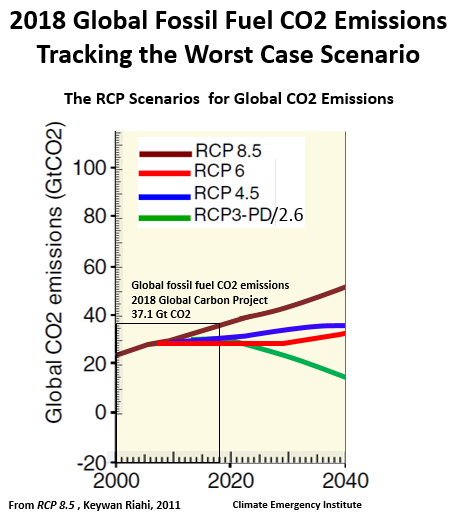
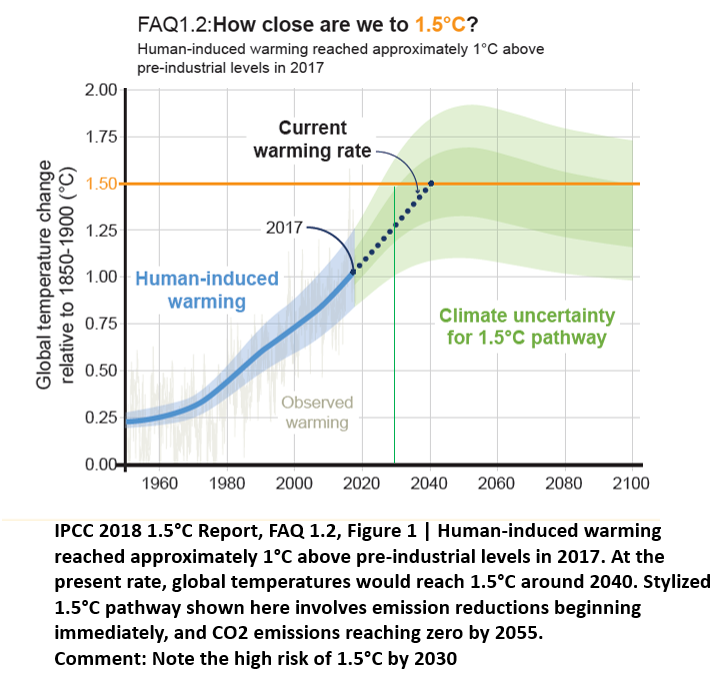
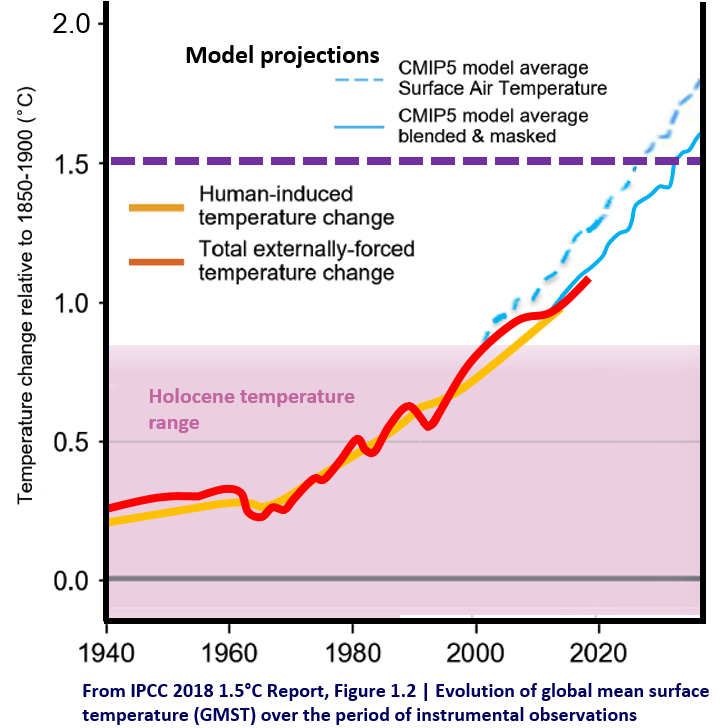
Future global surface heating and climate change commitment (higher than today's) is the most important and most ignored aspect of the science (it was covered best in the IPCC 2001 3rd assessment). It is essential information in policy making The case is made here that climate science commits us to a warming of 3C by 2100, which is the same as the policy commitment of national emissions targets filed with the UN
There is no agreed on definition of commitment. The best-case is in terms of future safety, for Humanity and Nature, assuming serious mitigation starts now, though there is no such mitigation in sight.
NO CO2 removal Any definition does not include assumed successful CO2 removal which is not feasible today of the foreseeable future and in any case is not economically feasible without a large carbon tax.
Permafrost commitment (at 1C) Permafrost is the largest single certain source of GHG feedback emissions caused by global surface warming, holding double atmospheric carbon. Permafrost thawing generates its own internal heat, making it irreversible. By a global warming of 1C, Arctic permafrost feedback emissions of methane, CO2 and nitrous oxide are well established. Therefore a sustained warming of over 1C, will eventually lead to irreversibly and increasing GHG permafrost feedback emissions. The sea-ice decline amplifying feedback will further boost these GHG feedback emissions. This requires emergency Arctic intervention intervention. Permafrost feedback is not included in IPCC temperature projections.
Over 1.5C is climate runaway commitment
For long the climate runaway danger trigger danger limit has been 2C, and recent research puts the trigger at over 1.5C. Any form of commitment over 2C is an end of the world commitment. Projecting impacts above 2C is a dangerous delusion, risking the future survival of the human race.
The IPCC science warming projections are very large under-estimates, which we will call "basic".
The IPCC science warming projections are very large under-estimates, which we will call "basic".
1. Feedback extra emissions The large sources of GHG feedbacks caused by global surface warming, are not included in the IPCC temperature projections, which makes them policy misleading underestimates. Including just land carbon feedback by 2100 adds another 30% to 2100 warming (IPCC 2007 AR4)
2. Low climate sensitivity Also they all assume a single climate sensitivity (3C for 2X CO2) but there is a lot of research now pointing to 4.5C and 6C. That adds another 30% by 2100.
3. Only by 2100 Since the IPCC 2007 4th assessment projections have only been 2100, not to the full long term equilibrium warming long after 2100, which is at least another 75% added to the 2100 warming (even excluding feed-backs)
4. Unmasking aerosol cooling, is an extra warming from fossil fuel air pollution emissions (atmospheric aerosols) that cause cooling, because to stop global warming burning fossil fuels has to stop. The extra warming is 0.4-0.8C (IPCC 2014 AR5)
The 2018 IPCC 1.5C Special Report claimed that it is possible to limit warming to 1.5C but this is only by 2100, and it only applies with immediate rapid decline of global emissions and all available means of sinking CO2. But in the Report a
50 year phase out of all CO2 (1.5C) and aerosol emissions (0.4C), leads to
1.9C by 2100, higher after 2100.
So 1.5C just by 2100 is not feasible, and the basic 2100 commitment is 2C.
2C by 2100 is 2.3C by 2300 (IPCC 2014 AR5).
Socio-economic-technological
Even the national emissions targets (NDCs) lead to
o Political: Fossil Corporate denial and pressure, policy maker & government denial, no binding international agreement, stalled UN negotiations, paltry national emissions suggested targets. Climate emergency has been declared by many jurisdictions, but this has not made a difference
o Social: public denial, lack of public call/support for emergency mitigation
o Economic: World and national credit based free market economics irrationally perverse for correcting climate change market failure, and governments are still subsidizing fossil fuels- crime of all time
o Technological: World has more than enough clean renewable energy to replace all fossil fuel energy. New compact liquid salt cooled fossil would be food for high energy dense power. Marine-small fission reactors used by US Navy year. Air travel has no alternative. Fossil fuel corporations claim their infrastructure must see out operating shelf life
o Social: public denial, lack of public call/support for emergency mitigation
o Economic: World and national credit based free market economics irrationally perverse for correcting climate change market failure, and governments are still subsidizing fossil fuels- crime of all time
o Technological: World has more than enough clean renewable energy to replace all fossil fuel energy. New compact liquid salt cooled fossil would be food for high energy dense power. Marine-small fission reactors used by US Navy year. Air travel has no alternative. Fossil fuel corporations claim their infrastructure must see out operating shelf life
Inertias or lag times contribute to commitment of a very much higher warming than today.
Climate science
All the climate science projections relay onr
Total by 2100 starting from basic 1.5C= +3.5C, at least double long after 2100
Atmospheric CO2 equivalent today is 500ppm, which is a basic 2.6C
o Ocean heat lag: At least 10 years and to peak, contributes to very long duration, eventual equilibrium another 75% of warming from atmospheric stabilization, the lag scientists generally mean (constant concentration commit), full equilibrium warming takes 1000s years, higher climate sensitivity means higher faster warming, later emissions peak= higher warming. Instant zero emissions commitment is about the same warming, but not a helpful definition.
Atmospheric CO2 eq is (2020) 500 ppm, a commitment of at least 2.6C, and more. The IPCC 2014 5th assessment put constant composition at 2C.
Atmospheric CO2 eq is (2020) 500 ppm, a commitment of at least 2.6C, and more. The IPCC 2014 5th assessment put constant composition at 2C.
o CO2 lag: thousands of years
o Feedback Amplifying (+ve) radiative (snow/ice albedo) & GHG feedbacks, not included in IPCC temperature models, many, very large and may last 1000s of years, combined cascading- hothouse Earth & runway. General land feedback alone is over another 1C by 2100 (IPCC 2007 4th assessment) Permafrost could add another 1C, loss of Arctic sea ice alone is 0.25C
o Feedback Amplifying (+ve) radiative (snow/ice albedo) & GHG feedbacks, not included in IPCC temperature models, many, very large and may last 1000s of years, combined cascading- hothouse Earth & runway. General land feedback alone is over another 1C by 2100 (IPCC 2007 4th assessment) Permafrost could add another 1C, loss of Arctic sea ice alone is 0.25C
o Carbon sinks (land/ocean) decline in efficiency- switch from sink to source, large, not included in models to 2100
o Unmasking of fossil fuel air pollution aerosol cooling, up to 1C, lasts decades, partial offset from decline of some fossil fuel black carbon (soot)
o Impacts are irreversible, and can last 1000s of years last
o Impacts are irreversible, and can last 1000s of years last
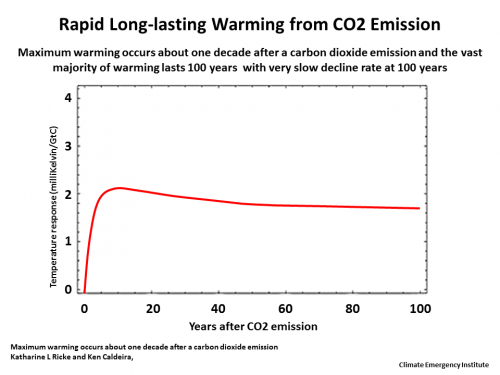

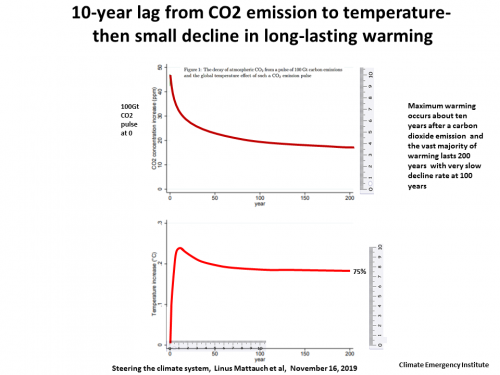


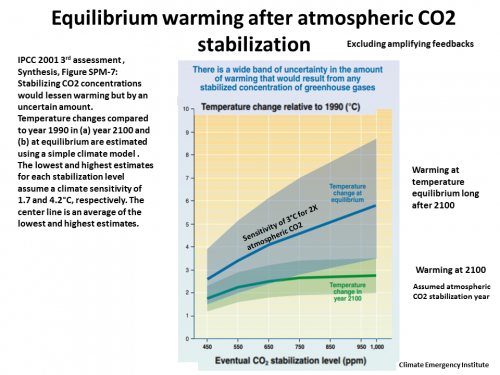
The IPCC 2001 3rd assessment remains the easiest assessment to understand, formatted as responses to questions in mainly lay language.
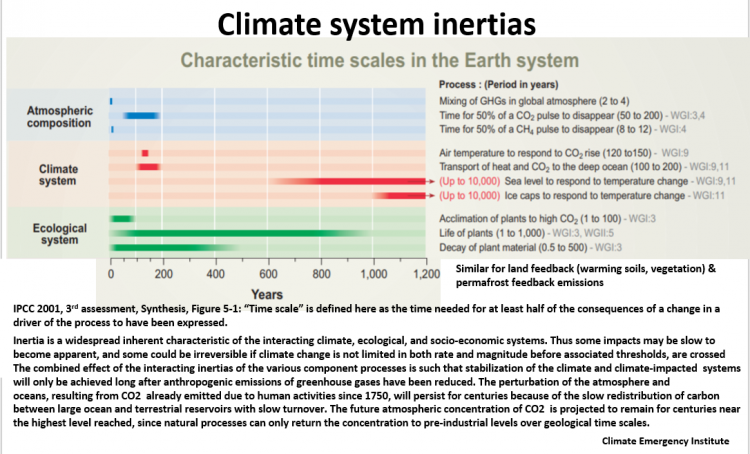
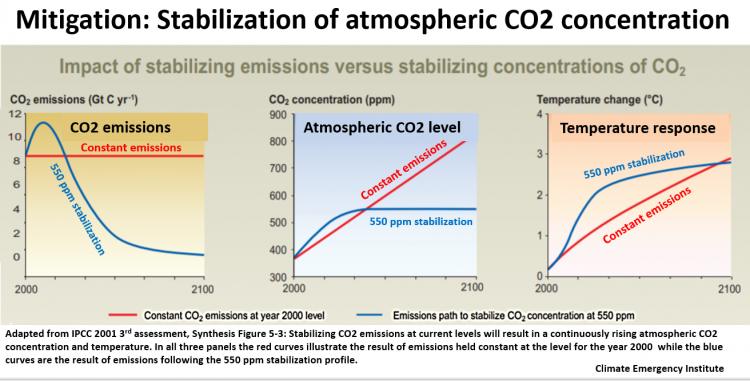
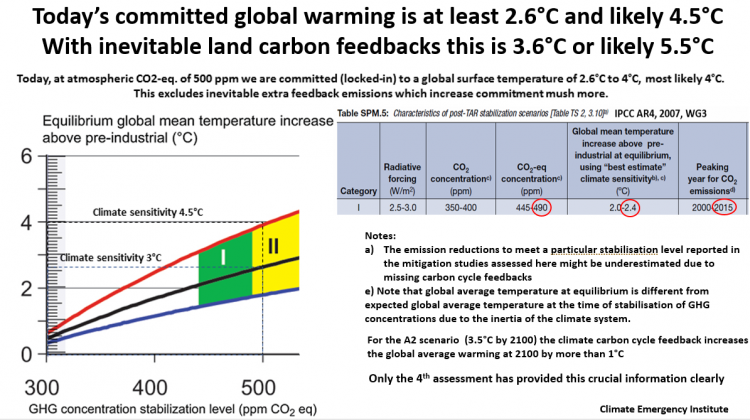
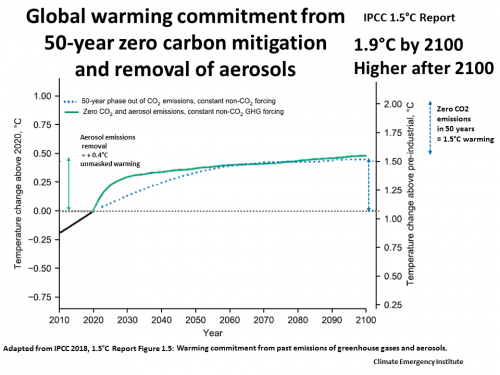
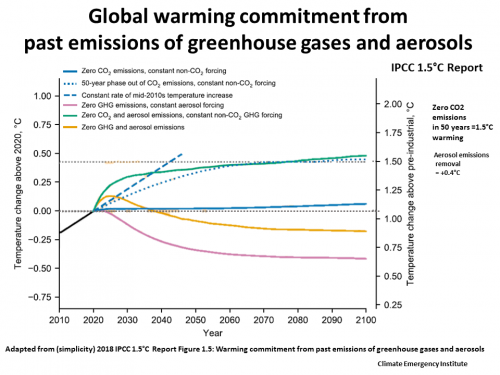
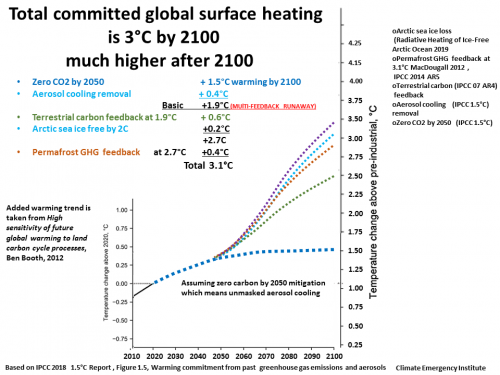
The scientific way to estimate basic commitment is from the atmospheric CO2 equivalent, which includes the temperature effect of all atmospheric greenhouse emissions.
Today's atmospheric CO2 equivalent is 500ppm and that is a full long term equilibrium
commitment of 2.6C (sensitivity 3C) and 4.5C (sensitivity 4.5C) BOTH FAR ABOVE RUNAWAY
Today's atmospheric CO2 equivalent is 500ppm and that is a full long term equilibrium
commitment of 2.6C (sensitivity 3C) and 4.5C (sensitivity 4.5C) BOTH FAR ABOVE RUNAWAY
Jan 2021 research shows (locked-in) commitment by 2100 is over 1.5C and full equilibrium warming is over 2C (long after 2100)